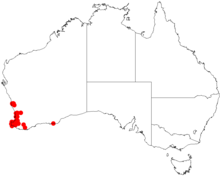| Acacia obovata | |
|---|---|
| Scientific classification | |
| Kingdom: | Plantae |
| Clade: | Tracheophytes |
| Clade: | Angiosperms |
| Clade: | Eudicots |
| Clade: | Rosids |
| Order: | Fabales |
| Family: | Fabaceae |
| Subfamily: | Caesalpinioideae |
| Clade: | Mimosoid clade |
| Genus: | Acacia |
| Species: | A. obovata
|
| Binomial name | |
| Acacia obovata | |

| |
| Occurrence data from AVH | |
Acacia obovata is a shrub belonging to the genus Acacia and the subgenus Phyllodineae that is endemic to south western Australia.
Description[edit]
The erect dense shrub typically grows to a height of 0.3 to 0.6 metres (1.0 to 2.0 ft).[1] It is often has multiple slender stems and has a woody rootstock with hairy branchlets and narrowly triangular stipules with a length of 1.5 to 4 mm (0.059 to 0.157 in). It has green elliptic to broadly elliptic or obovate shaped phyllodes with a length of 1.5 to 5 cm (0.59 to 1.97 in) and a width of 1 to 2.5 cm (0.39 to 0.98 in) and prominent midrib and marginal nerves.[2] It blooms from March to September and produces white-cream-yellow flowers.[1] The inflorescences occur singly with spherical flower-heads containing five to nine loosely packed yellow to white coloured flowers that dry to an orange colour. The woody brown seed pods that form after flowering have a linear shape but can be spirally twisted when young. The pods have a length of around 11 cm (4.3 in) and a width of 5 to 6 mm (0.20 to 0.24 in) to 11 cm long, 5–6 mm wide, coriaceous-crustaceous to subwoody, glabrous; margins thick and contain glossy dark brown seeds with an oblong to elliptic shape.[2]
Taxonomy[edit]
The species was first formally described by the botanist George Bentham in 1842 as a part of William Jackson Hookers' work Notes on Mimoseae, with a synopsis of species as published in the London Journal of Botany. It was reclassified as Racosperma obovatum by Leslie Pedley in 2003 then transferred back to genus Acacia in 2006.[3]
Distribution[edit]
It is native to a scattered area along the west coast in the South West, Peel and Wheatbelt regions of Western Australia where it grows in lateritic soils.[1] It is found as far north as Jurien Bay with a disjunct distribution south through parts of the Darling Range down to around Augusta where it is often a part of Eucalyptus marginata and Corymbia calophylla forest communities and less frequently in low open heath lands.[2]
See also[edit]
References[edit]
- ^ a b c "Acacia obovata". FloraBase. Western Australian Government Department of Biodiversity, Conservation and Attractions.
- ^ a b c "Acacia obovata". World Wide Wattle. Western Australian Herbarium. Retrieved 19 May 2019.
- ^ "Acacia obovata Benth". Atlas of Living Australia. Global Biodiversity Information Facility. Retrieved 19 May 2019.